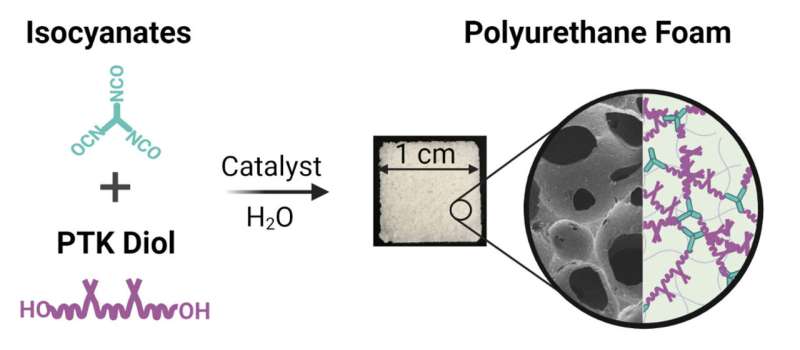June 30, 2022 feature
In development: A synthetic foam that heals chronic wounds by suppressing inflammation and spurring blood vessel growth

Scientists have engineered a synthetic biodegradable foam that can suppress inflammation, promote blood vessel growth and support the rapid healing of chronic skin wounds, an innovation that may one day improve treatment for ailing patients and possibly reduce costs of a major global health problem.
The new material, tested in pigs with chronic skin wounds, matched or outperformed a clinical wound-healing product considered the "gold standard" of care. The research suggests that the investigational material may one day accelerate tissue repair among patients with skin wounds that have defied healing.
Chronic skin wounds afflict an estimated 4.5 million people in the United States alone, and are responsible for $96.8 billion in U.S. healthcare costs. Wound healing problems are equally expensive and pervasive in other countries, which makes the issue a global health concern, according to the World Health Organization.
In Tennessee, Vanderbilt University scientists are working on a biodegradable foam dressing that accelerates the repair of chronic skin wounds while reducing inflammation and promoting angiogenesis. So far, the team's animal studies, which have been reported in Science Translational Medicine and bioRxiv, have suggested the biodegradable foam dressing holds promise for humans.
"Impaired skin healing and progression into chronic wounds is a prevalent and growing medical problem," writes lead author Prarthana Patil, along with a team of Vanderbilt researchers, who are developing a polythioketal urethane foam dressing to eventually treat defiant wounds, such as slow-healing skin ulcers or contusions emanating from trauma.
All scientific results to date have involved the porcine animal model. And while the pigs' rapid healing was remarkable, the improvement didn't involve any natural materials, just the highly specialized synthetic biomaterial.
"Naturally-derived biomaterials have promising healing benefits, but their low mechanical properties and exorbitant costs limit their performance and use," Patil asserted. "Synthetic materials can be affordably manufactured and attuned across a broader range of physiochemical properties. Polyesters are the most clinically-tested class of synthetic biomaterials, but their hydrolysis releases acidic degradation products that can cause autocatalytic degradation."
Enter something wildly different: The Vanderbilt dressing, which, at least in pigs, helps promote effective, rapid healing by promoting new healthy tissue growth and spurring development of healthy new blood vessels. The material is not only less expensive to produce, it can be molded into a broader range of physical properties, scientists say.
In the porcine excisional wound model, the new foam achieved higher wound healing scores, better vascular perfusion, and stronger control of inflammation compared with the approved NovoSorb Biodegradable Temporizing Matrix product. The polythioketal urethane foam also matched the performance of the widely used Integra Bilayer Wound Matrix, considered the "gold standard" in hospitals. The finding from the porcine research suggests the new foam might eventually offer a high-performing synthetic alternative in clinical settings.
Skin wounds that fail to heal, heal slowly, or tend to recur are called chronic skin wounds. There are multiple reasons that chronic wounds occur—diabetes is a major cause, particularly diabetic skin ulcers. But other chronic problems abound: trauma, burns, infection, vascular problems and skin cancer. Wounds that take a long time to heal require special care and that helps explain why scientists have long been on the hunt for better, more effective biomaterials.
"Chronic ulcers take approximately 1 year to heal on average in adults; recurrence rate is high, and the 5-year mortality rate is about 40 percent for patients who experience diabetic skin ulcers," Patil and colleagues wrote. "Chronic wounds are characterized by persistent, low-grade inflammation with an influx of polymorphic mononuclear leukocytes that secrete inflammatory cytokines, proteolytic enzymes that breakdown extracellular matrix and growth factors. Excess reactive oxygen species causes oxidative stress and reduces angiogenesis, extracellular matrix deposition, and healing capacity of fibroblasts and keratinocytes."
Worse, unclosed wounds have a high incidence of bacterial infection and biofilm formation, the team wrote in their study, noting that the potentially life-threatening situation further exacerbates the local inflammatory imbalance.
"We systemically explored a series of reactive oxygen species-degradable polythioketal urethane foams with varied hydrophilicity as an alternative class of synthetic biomaterials for wound healing," Patil and the team reported.
Most chronic skin wounds are treated with either traditional wound dressings or newer options such as synthetic or animal-derived biomaterials that mimic the supportive extracellular matrix. Several animal-derived extracellular matrix dressings have been approved for the clinic, but they face challenges with raw material sourcing and very high costs. A cost-effective material with the capacity to accelerate healing would be a game changer.
More information: Prarthana Patil et al, Reactive oxygen species–degradable polythioketal urethane foam dressings to promote porcine skin wound repair, Science Translational Medicine (2022). DOI: 10.1126/scitranslmed.abm6586
© 2022 Science X Network




















